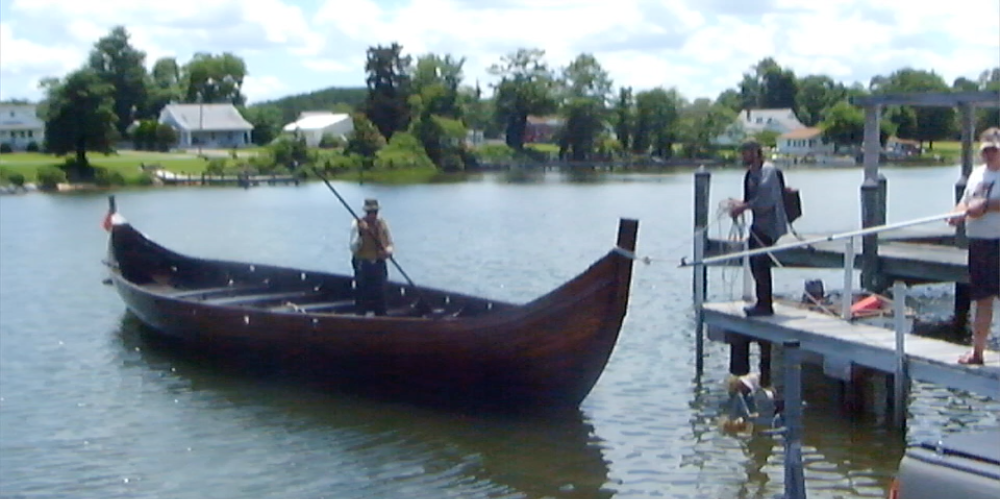All weight should be removed when lifting the færing onto or
off of the trailer. Get help if a launch is difficult, and
hand carry the færing to the water’s edge.
Never get the trailer in the water;
it is not made for it.
|
| 5.10.5 Boarding and safety |
|---|
| |
The Gyrfalcon has very low initial stability
(“to the wrong side of a canoe”) which
means that if you board it wrong, or make a wrong
move, you (and probably everyone already on board)
will be going for an unexpected swim. She does,
however, grow stiffer as more crew board her. When
boarding, step to the center (on the keel, not the
thwart) keeping your weight low and balanced. Move
carefully to your assigned position and sit down.
Do not overload the boat. A five–person maximum
(with no heavy equipment) is all she will take in
good to moderate conditions. If the weather picks
up, four is more sensible. Three is the standard
crew for rowing, and the minimum for sailing. When
used as a dinghy, one can row it back to the ship.
With all crew seated and weight stowed low, any change of
position should be announced beforehand and carried
out slowly and deliberately.
Do not stand up! People
changing positions fore and aft, especially around
the mast, will need to coordinate their motions so
as to balance each other as they place their centers
of gravity further out on the beam.
A life vest will accompany each Crewmember, and will be
worn except in special situations, such as invasions
and exhibitions. The færing must also carry
at least one throwable flotation cushion, three
flares, and — at night — a functioning
flashlight or lantern.
|
|
| 5.11 Trailering the
færing |
|---|
| 5.11.1 Packing |
|---|
| |
Do not overload the rig. Keep any heavy objects in your car (on the
floor, where you have no passengers) or in the stern of the
færing. The tongue weight is about 170 pounds. Stern
loading will help to keep it reasonable.
The motion and vibration of towing causes chafing, so oars, spars
and other items must be tied down and cushioned. Light
objects such as life jackets and fenders must be either
tied down or stowed in the car to prevent them from blowing
away. Hard and heavy objects such as anchors and tool boxes
should be carried in the vehicle to keep them from damaging
the wooden hull.
Before attempting to tow the færing, be sure to check each
of these items:
- Trailer Tongue attached?
- Safety Chains attached?
- Electrical System Connected: Test running lights, brake
lights and turn signals.
- Mast Lowered?
- Boat tied down?
- Red Towing Flag attached to stern?
- Trailer registration in your possession?
- Bolt or lock Trailer Hitch and don’t lose the key.
|
| 5.11.2 Overheating |
|---|
| |
Since your engine is working harder pulling the rig,
it’s also running hotter. Before you leave,
be sure your radiator is full and the cap secure.
(It would also be wise to check your oil, battery,
transmission fluid, tire pressure, etc. while
you’re at it.)
If you have time for it, you should make a mid–trip
stop to let things cool down, check under the hood,
and give yourself a break. Inspect the rig while
you’re at it, and check the trailer hubs to
see if they’re running hot from any bearing
trouble.
If you suspect that your engine is in danger of overheating,
you should run the car’s heater. Since it
works by drawing heat from the engine coolant,
it will assist the radiator in keeping the
engine temperature down.
|
| 5.11.3 Potholes, bumps and
railroad tracks |
|---|
| |
Because of the trailer’s small–diameter wheels
and its light cargo, the whole rig tends to fall
into depressions in the road, then launch itself
into the air. Keeping your speed down on unfamiliar
back roads or potholed highways gives you a chance
to steer around an obstacle or slow down to minimize
the impact, preventing damage to the trailer or the
færing. Railroad tracks are the worst. If
you must cross a badly–graded railroad, put
on your emergency blinkers, come to a complete stop,
look both ways and — if it’s clear
— ease the rig across the tracks.
|
|
|
